Gasket for valve and other stop valves
How to change the gasket in the faucet in the bathroom or in the kitchen? Where to get the replacement of the old gasket? Is it possible to make it yourself? How to replace the gasket and the gland at the screw valve? Is it possible to eliminate the leak ball valve? Let's try to answer these questions.
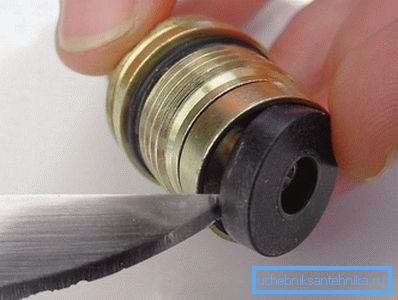
Device kranbuksy
Let's start from afar. In domestic and imported mixers can be found screw kranbuksy two types.
With stuffing box
The threaded rod rotates inside the valve body. On the saddle side, a valve is fixedly attached to it, which holds the gasket with a screw with a washer or retainer, a shape resembling a small fungus.
When the valve is open, the absence of leakage from under the stem is provided by a graphite or oil seal: it is packed into the space around the stem and clamped with the nut screwed in from above.
Nuance: so that the gland does not grind the thread, from below it should limit the puck. Unfortunately, some unscrupulous manufacturers extremely simplify the design and get rid of it. If the price of kranbuksy significantly lower than the market average - it is better to go through it and check the completeness before buying.
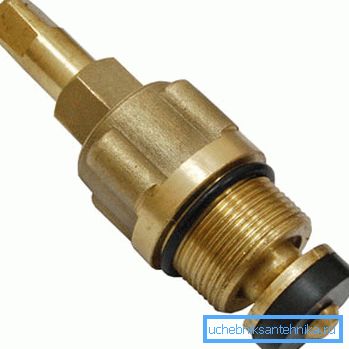
With rubber seal
The rod remains stationary during rotation, squeezing the hex slider towards the seat with a rigidly fixed valve. The tightness of the rod is provided by a pair of rubber rings; its immobility relative to the body - locking washer. (See also the article Hermetic for pipes: features.)
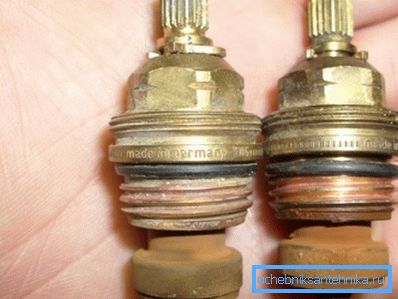
About terminology
Why does the reader need to know how the kranbuks are arranged, if he is only interested in how to replace the gasket in the faucet? You see, the author, while working as a plumber, got used to the fact that the most unexpected fixtures to ensure tightness are often called pads.
For example, the phrase “gaskets for ball valves” is often understood not as ensuring the tightness of the connection between the halves of the casing of the collapsible element of the stop valve, but the stuffing box seal on the stem. (See also the article How to choose a sink faucet: features.)
Hence the natural desire to satisfy the curiosity of readers who are confused in terminology.
Repair kranbuks
So, let's look at a few typical faults screw valves.
Given: when the faucet is closed with effort, water continues to drip.
There can be two reasons for this:
- Dross caught between the valve and the seat. To remove it is often enough several times before refusing to open and close the faucet.
- Worn, lost elasticity or completely destroyed gasket.
How to change the gasket in the faucet in the kitchen or in the bathroom in the latter case?
- Shut off the water.
- Open the valve until it stops.
- Remove the lamb (grip). The screw is usually closed tightly inserted or unscrewed stopper.
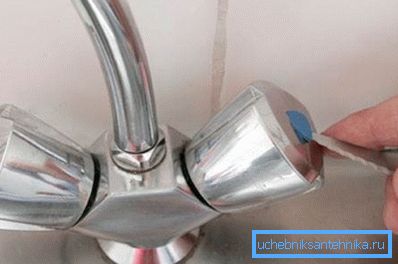
- With an adjustable or rozhkovy key (as a rule, on 17 or 19) we unscrew the bush.
- Inspect the valve. If the gasket has obvious defects - remove it from the valve: unscrew the locking screw with a screwdriver or hook up the gasket, pulling it from the lock-fungus.
- Install the replacement.
- Take the scissors and cut the chamfer on its outer edge. This is necessary in order to eliminate hydraulic noises: the replacement of the gasket in the valve with a new one often leads to the fact that when opened, the valve starts to beat in the turbulent flow.
- Putting the mixer in the reverse order. Turn on the water. Check the health.
Given: when the tap is open, water flows along the stem. What to do in this case?
For the axle box with the gland it is sufficient to remove the butterfly and unscrew the packing nut with the valve fully closed. The packing is wound on the rod and sealed with a screwdriver; the nut is tightened with moderate force. It is best to use loose graphite gland for valves.
For a crane with a rubber o-ring, the instruction is somewhat more complicated.
- Turn off the water and remove the lamb.
- Unscrew the bush.
- Fully disassemble it, turning the rod clockwise until it stops.
- Remove the lock washer and push it out.

- We change two ring gaskets - seal.
Nuance: if the ring gasket for the crane-axle box is not in the nearest plumbing store, it is easier to buy the axle box entirely. Its cost is not so high as to spend considerable time searching. In order not to be unsubstantiated, we give several market offers.
| Organization | City | Retail cost kranbuksy, rubles |
| Brozex | Yekaterinburg | 59,56 |
| Profi-optorg | Moscow | 36.40 |
| Atlant-S | Kazan | 30.45 |
| Vitto | Krasnodar | 36 |
Where can I get a gasket that covers the water? They are sold both in retail and in sets, including seals for cutter knives (eccentrics), mixer glands, etc. One problem - they are usually made of soft rubber and not too durable.
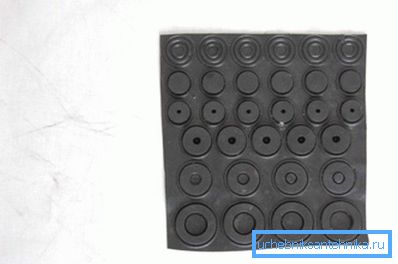
What to make a gasket for a crane that will last longer than the factory? From maslobenzostoykoy rubber 8 - 10 mm thick. Gaskets are cut by cuts - large and small (under a screw or a clamp) - on a wooden base.
Useful stuff
- Old-style screw valves usually have paronite or thick leather. When worn, it is easiest to replace them with hand-carved articles of the size of old car cameras. The tool is ordinary scissors and a small hole for the screw hole.
- At cork and screw valves the stuffing box is packed with graphite thread. As a temporary, you can use an oil pad or even a cab, but they do not last long.
- If you disassembled the body of the ball valve - when assembling for sealing, use FUM tape or polymer sealing thread, not a gasket.
- If the ball valve has a gland drip - uncheck the box or the levers, instead of the gland, tamper with a tape FUM or polymer thread. Then put the flag in place and tighten the nut: the gland will tighten. Of course, such sealing is unequal to the standard one, but it is quite efficient.
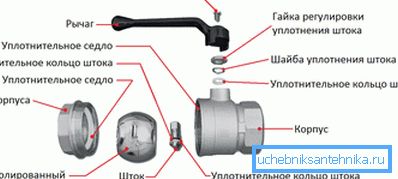
Conclusion
We hope that our recommendations will allow the reader to meet petty domestic troubles fully armed. As usual, the video in this article will offer additional thematic materials. Successes!